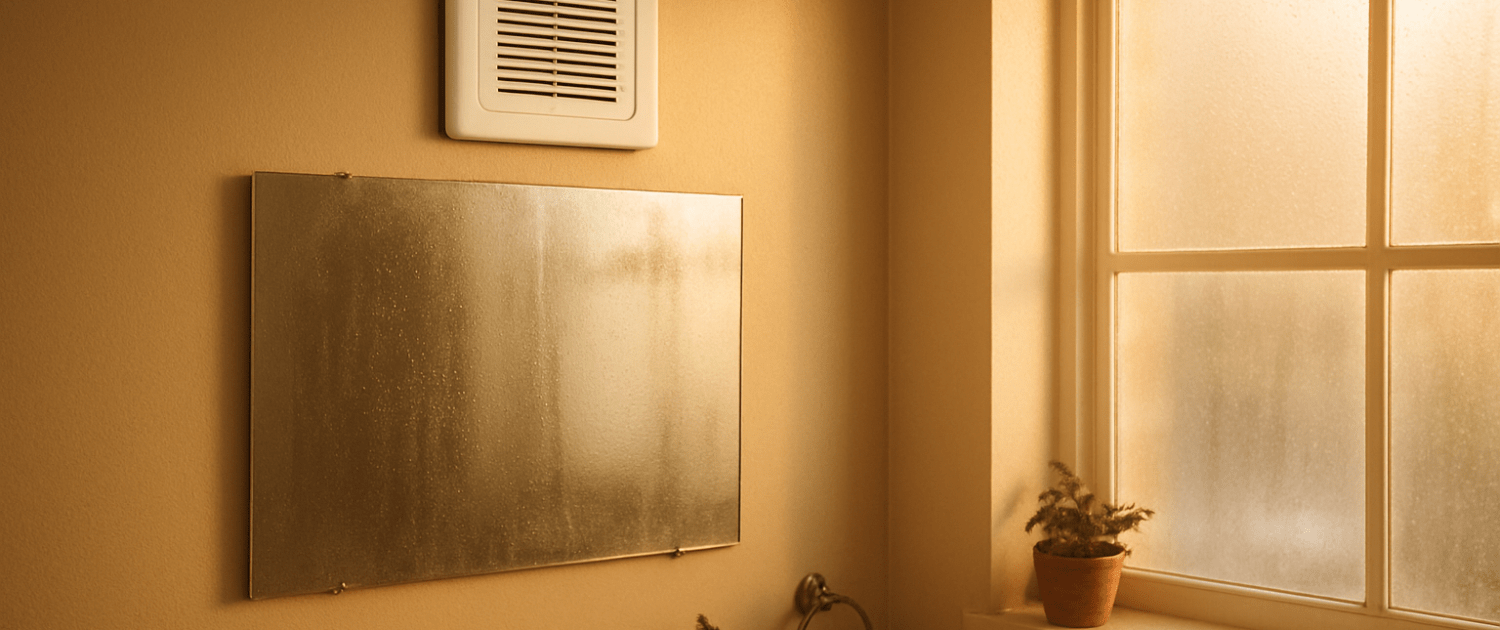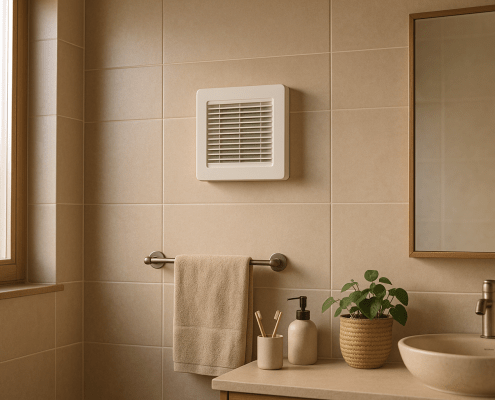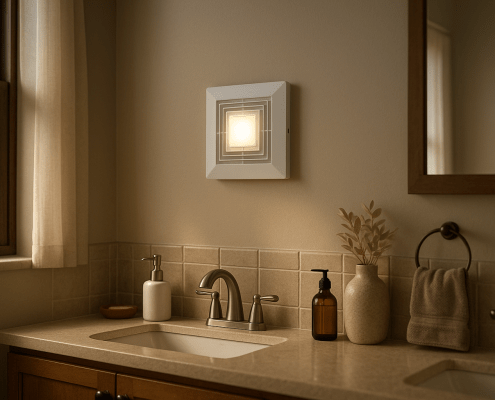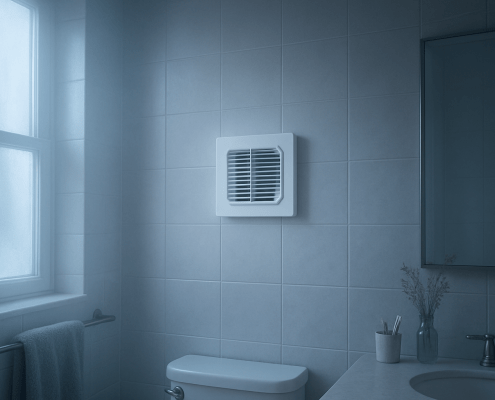Why Bathroom Vent Fans Are Key to Preventing Bathroom Mold
Steven E / Tuesday July 1, 2025
If you’ve ever stepped into your bathroom and noticed a musty smell, peeling paint, or dark spots forming on the ceiling, there’s a good chance poor ventilation is to blame. Bathrooms are high-humidity zones, and without proper airflow, they can quickly become a breeding ground for mold and mildew. We’ll break down why bathroom ventilation is essential and what you can do to improve airflow in your home.
The information in this article may not apply to your specific appliance model. We recommend consulting your manufacturer’s documentation or contact us with any questions.
The Problem With Poor Bathroom Ventilation
Bathrooms are unlike other rooms in the house. They’re exposed to high levels of moisture multiple times per day, through showers, baths, and handwashing. If that moisture isn’t properly vented out, it lingers in the air and settles on surfaces, where it creates the perfect conditions for mold to grow.
Here’s what can happen in a poorly ventilated bathroom:
- Excess moisture gets trapped on walls, ceilings, and floors
- Paint or wallpaper begins to peel or bubble
- Wooden trim or drywall may warp or decay
- Mold spores start colonizing on tile grout, walls, ceilings, and vents
- Persistent odors develop due to mildew and bacterial buildup
All of these issues can not only ruin the look of your bathroom but also affect your indoor air quality and even your health.
How Moisture Leads to Mold Growth
Mold is a type of fungus that thrives in damp, dark, and poorly ventilated environments. It only needs a few basic elements to grow:
- Moisture (from steam or leaks)
- Organic material (like drywall, wood, or dust)
- Warmth (common in most homes)
- Time (mold can grow in as little as 24 to 48 hours)
Once mold gets a foothold, it spreads quickly. Some species release spores into the air, which can cause allergies, asthma symptoms, and other respiratory issues. Mold can also damage structural components of your home over time, leading to expensive repairs if left untreated.
The bottom line: Mold prevention starts with moisture control, and moisture control starts with good ventilation.
Benefits of Proper Bathroom Ventilation
Installing and maintaining effective bathroom ventilation isn’t just about avoiding foggy mirrors. It’s a critical step in preventing mold, preserving building materials, and improving air quality.
Here are the primary benefits:
- Reduces Humidity: A properly functioning exhaust fan helps pull humid air out of the bathroom before it condenses on surfaces.
- Prevents Mold and Mildew: Lower moisture levels reduce the chances of mold spores finding a place to grow.
- Protects Walls and Ceilings: Paint, drywall, and wood trim last longer when they’re not constantly exposed to damp conditions.
- Improves Indoor Air Quality: Exhaust fans help expel odors and airborne contaminants, leaving the air fresher and healthier.
- Complies With Building Codes: Most modern building codes require ventilation in bathrooms without operable windows.
Signs Your Bathroom Ventilation Isn’t Working
If you’re unsure whether your current setup is doing the job, here are some telltale signs that your bathroom ventilation needs attention:
- Lingering moisture: Water stays on mirrors, windows, or walls for more than 15–20 minutes after a shower.
- Visible mold or mildew: Especially around corners, ceilings, or behind toilets and vanities.
- Peeling paint or wallpaper: Bubbling, flaking, or discoloration near the ceiling or around tile edges.
- Warped wood: Baseboards, door frames, or cabinetry showing signs of swelling or separation.
- Musty odors: Persistent smells that don’t go away even after cleaning.
If you notice any of these problems, it’s time to investigate and improve your bathroom’s ventilation system.
How to Improve Bathroom Ventilation
There are several ways to boost bathroom airflow, ranging from simple fixes to full upgrades. The right approach depends on your bathroom’s layout, usage, and existing equipment.
Install or Upgrade an Exhaust Fan
This is the most effective way to remove humid air.
- Choose a fan rated appropriately for the size of your bathroom (measured in CFM, cubic feet per minute).
- Install a timer switch or humidity sensor so the fan runs long enough to clear moisture after use.
- Vent the fan to the outside of the house, not into the attic or ceiling cavity.
- Clean the fan and vent duct at least once a year to maintain performance.
Use the Fan Properly
Many people don’t run their exhaust fans long enough.
- Turn the fan on before taking a shower or bath.
- Let it run for 15–20 minutes afterward to clear lingering humidity.
- If your fan is noisy or underpowered, consider replacing it with a newer, quieter, and more efficient model.
Add a Window or Operable Skylight
If your bathroom has a window, opening it during and after showers can help ventilate the space naturally.
- Use window fans or vented shutters to enhance airflow.
- Make sure screens are in place to prevent insects from entering.
- If remodeling, consider adding a window or skylight as a passive ventilation option.
Use a Dehumidifier
In especially humid climates or in bathrooms without ventilation infrastructure, a small plug-in dehumidifier can help.
- Choose a unit designed for small rooms (20–30 pint capacity).
- Empty the water reservoir regularly or use a model with a drain hose.
- Place the unit near the shower or bathtub for maximum effect.
Keep Doors and Curtains Open
- Once you’re done using the bathroom, leave the door open to allow fresh air to circulate.
- Pull back the shower curtain or open the glass doors to let the enclosure dry out.
- Wipe down wet surfaces like walls and tile with a squeegee or towel to remove excess moisture.
Maintaining Your Ventilation System
Like any appliance, a bathroom exhaust fan needs occasional care to work properly.
Simple maintenance steps include:
- Clean the fan grill: Dust buildup can restrict airflow; remove and wash the grill every few months.
- Check for vent blockages: Go outside and confirm that air is exiting freely from the duct.
- Inspect for mold: Look inside the fan housing for any signs of mildew or mold growth.
- Listen for unusual noises: A rattling or buzzing fan might mean the motor is wearing out.
Mold Prevention is Cheaper Than Mold Remediation
If you’re still wondering whether it’s worth the time and effort to upgrade your ventilation, consider the cost of doing nothing. Mold removal is expensive, time-consuming, and in some cases, requires professional abatement services. In contrast, a properly functioning fan costs pennies a day to run and could save thousands in future repairs. Investing in ventilation is not just about comfort; it’s about protecting your property and health.
Where To Find Us
If you need any replacement parts for your appliances, you can enter your model number at AppliancePartsPros.com to locate and order them quickly. Most orders arrive in just two business days, and we have tons of great information in our repair help section and YouTube videos to help you troubleshoot.
Stay connected with the latest DIY tips, tutorial videos, and repair guides by following us on Facebook, Instagram, and Twitter. We love hearing about your repair stories and successes. If you need more help or want personalized guidance, feel free to reach out. We’re ready to help you take on your next project with confidence!
With nearly a decade of experience in providing top-notch customer service regarding appliance parts and repair, Steven enjoys sharing practical advice, troubleshooting tips, and interesting information to help readers stay informed.





